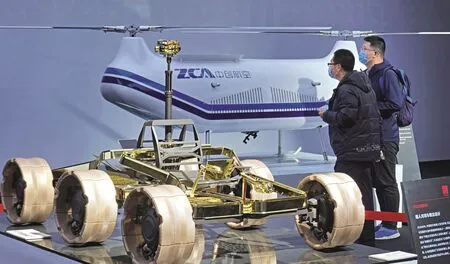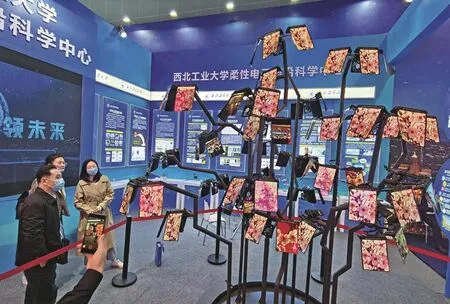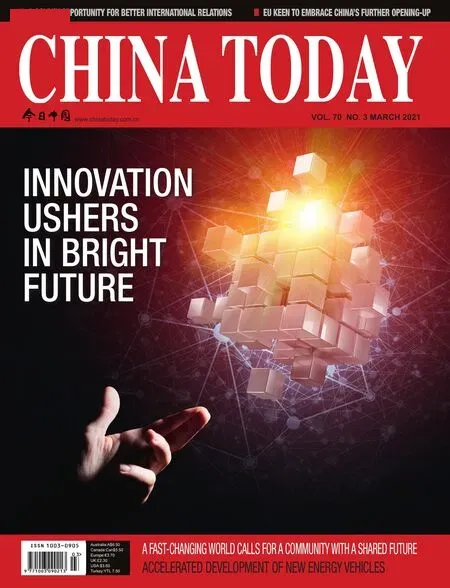Fostering R&D Force for National Growth
By BAI CHUNLI

Visitors appreciate models at an exposition of China’s top industrial designs, which is part of the 2020 World lndustrial Design Conference held in late November in Yantai, east China’s Shandong Province.
THE 19th Central Committee of the Communist Part of China (CPC) made proposals for the formulation of the 14th Five-Year Plan (2021-2025) for National Economic and Social Development and the Long-Range Objectives Through the Year 2035 at its fifth plenary session. The proposals took into consideration the current changing trends at home and abroad, and China’s urgent need for highquality science and technology achievements in economic and social development in the new era. Taking a goal-oriented and problem-centered approach, the proposals offer comprehensive solutions to strengthening the capability of the national force for scienti fic and technological research and development (R&D),and point to the direction for innovation during the 14th Five-Year Plan period and beyond.
For Rapid Scienti fic and Technological Progress
Since the 18th CPC National Congress, the CPC Central Committee under the leadership of General Secretary Xi Jinping has placed scienti fic and technological innovation at the center of China’s overall development plan.
China has made unprecedented efforts in fully implementing the strategy of innovation-driven development by strengthening its national R&D capacity, signi ficantly improving the overall efficiency of the country’s innovation system. As a result, it has brought about historic changes and achievements in scienti fic and technological innovation.
China’s total expenditure on R&D in 2019 amounted to RMB 2.21 trillion (equivalent to US $321.3 billion). The figure hit a record high at 2.23 percent of its GDP, exceeding the average level of the EU. China has ranked first in the world for the number of invention patents granted for many consecutive years.The country submitted the most patent applications through the Patent Cooperation Treaty. It ranked second in the world in terms of the total numbers of both international scienti fic papers and highly cited papers. These figures show that China is an important contributor to global scienti fic and technological innovation.
Major breakthroughs have been made in key frontier areas. The strength of basic research has been improved signi ficantly. The overall levels of the country’s academic disciplines, including chemistry,materials science, physics, and engineering, have reached international advanced standards. Major breakthroughs were made in a large number of strategic high-tech areas, including manned spacecraft and moon exploration, the BeiDou Navigation Satellite System, homegrown large passenger aircraft, deep-sea manned submersible, domestically produced aircraft carriers, high-speed railways, 5G mobile technology,supercomputing, ultrahigh voltage power transmission, and homemade third-generation nuclear reactors. All of these are contributing to foster new drivers for economic development. This in turn promotes industrial transformation and upgrading, and safeguards national security. In addition, scienti fic and technological innovation has also played an irreplaceable role in combating the COVID-19 pandemic, winning the battle against extreme poverty, securing and improving people’s livelihoods, and building a beautiful China.
The spatial distribution of China’s scienti fic and technological innovation system continues to improve. China has made progress in building international science and technology innovation centers in Beijing, Shanghai, and the Guangdong-Hong Kong-Macao Greater Bay Area. Efforts were expedited in building hubs of science and technology innovation that have global in fluence, and in fostering core engines to drive high-quality development. The construction of comprehensive national science centers in Huairou District of Beijing, Zhangjiang high-tech park of Shanghai, and Hefei City of Anhui Province is in full swing. The continuous improvement of innovation capacity in key regions, such as national innovation demonstration zones and high-tech industrial zones, has also greatly accelerated the development in neighboring regions.
Signi ficance of Building a Leading National R&D Force
The world is undergoing profound changes unseen over the past century. Innovation has become the key variable that in fluences and changes the landscape of global competition. China has entered a new stage of high-quality development. To tackle risks and challenges and solve bottleneck problems, China urgently needs stronger support from technological innovation. China aims to become a global leader in innovation in 2035, and emerge as a country with strong strengths in science and technology by the middle of the century.
Building a leading national R&D force is the key to adapting to the changes in the competitive international economic and technological landscape and to seizing the opportunities offered by the new round of scienti fic and technological revolution and industrial transformation. On the one hand, the COVID-19 pandemic is exerting a profound in fluence on the world; economic globalization is seeing a countercurrent; the global industrial chain and supply chain have been disrupted by noneconomic factors; and international scienti fic and technological exchanges and cooperation are blocked. The external environment has become more complicated for the country as a whole.
On the other hand, amid the ongoing round of scienti fic and technological revolution and industrial transformation, different academic disciplines and fields are merging and integrating, giving birth to many cross-disciplinary breakthroughs. Focusing on major innovation and the current disruptive technologies that are likely to yield revolutionary breakthroughs, various countries have continued to increase input in R&D in an effort to seize the initiative in future competition landscape.
Building a leading national R&D force will help China give full play to its multi-disciplinary and institutional advantages, accelerate efforts to make major breakthroughs in core technologies, occupy the commanding heights of science and technology, and realize a high level of self-reliance and self-improvement in relevant fields of development. In this way, the country will be better equipped to take part in international scienti fic and technological competitions and cooperation, and contribute more of China’s valuable experience and strength to the progress of science and technology around the world.
A strong national R&D force is essential for generating new growth drivers and supporting high-quality economic and social development. Innovation is the primary driving force for development, whether it is in fostering new drivers for growth, developing emerging industries, transforming and upgrading traditional industries, or in improving people’s living standards,protecting the ecological environment, and safeguarding national security.
However, it’s important to recognize that China’s innovation capacity has not yet met the requirements for high-quality development. Its strengths in basic research and original innovation are still weak, and there has been no fundamental change in its reliance on other countries for core technologies in key fields.
As China faces a series of new opportunities and challenges brought about by profound changes in the domestic and international environment, the CPC Central Committee has made a major strategic choice to accelerate the construction of a new economic development pattern called “dual circulation,” in which the domestic circulation is the mainstay and the international circulation and domestic circulation reinforce each other. Scienti fic and technological innovation is the key to this new development pattern.
Leveraging its strength in mobilizing national resources for scienti fic research and development,China will better improve its capacity for independent innovation and provide stronger scienti fic and technological support for pursuing a path of high-quality development that is safer, fairer, more efficient and more sustainable.
Building a leading national R&D force is an important way to optimize the layout of China’s national innovation system as well as to build and promote the overall system of scienti fic and technological innovation. The leading national R&D force is the “national team” for scienti fic and technological innovation. It represents the highest level of China’s capacity for innovation and is the pillar of the national innovation system.
A review of the history of major countries with strong scienti fic and technological capacities since modern times reveals that well-established national research institutions and high-level research-oriented universities, major platforms for science and technology R&D, and state-funded science and technology projects play important roles in expediting the growth of national capacity for innovation and maintaining a country’s competitive edge in science and technology fields.
Under the current stage of development, strengthening national R&D capacity by empowering key institutions of key fields in key regions to take the lead in achieving high-quality development is conducive to optimizing the overall layout of China’s national system for innovation. It will also help boost the capacity of other entities and sectors under the system, and ultimately improve the comprehensive scienti fic and technological strength and overall efficiency of the country’s innovation system.
The leading national R&D force dominates highlevel scienti fic and technological innovation activities.It is also a hallmark of a country with strong science and technology capacity. It is necessary to integrate national resources for innovation and build state laboratories and R&D bases for interdisciplinary and collaborative innovation projects in research areas where China has advantages and strategic interests and is likely to make signi ficant progress. The state key laboratories should grow even stronger through merging and integration so that they are more capable of ful filling major national R&D tasks.

Visitors marvel at the paper-thin,flexible electronic displays developed by Northwestern Polytechnical University at the 17th China-ASEAN Expo on November 29, 2020.

